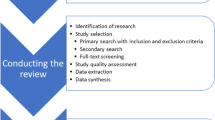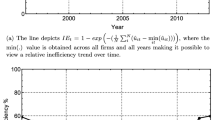Abstract
There has been increasing interest in the ability of different methods to rank efficient hospitals over their inefficient counterparts. The UK Department of Health has used three cost indices to benchmark NHS hospitals (Trusts). This study uses the same dataset and compares the efficiency rankings from the cost indices with those obtained using Data Envelopment Analysis (DEA) and Stochastic Frontier Analysis (SFA). The paper concludes that the methods each have particular strengths and weaknesses and potentially measure different aspects of efficiency. Several specifications should be used to develop ranges of inefficiency to act as signalling devices rather than point estimates. It is argued that differences in efficiency scores across different methods may be due to random “noise” and reflect data deficiencies. The conclusions concur with previous findings that there are not truly large efficiency differences between Trusts and savings from bringing up poorer performers would in fact be quite modest.
Similar content being viewed by others
REFERENCES
B. Hollingsworth and D. Parkin, Developing efficiency measures for use in the NHS, A report to the NHS Executive Northern & Yorkshire R&D Directorate, Health Economics Group, University of Newcastle (1998).
N. Söderlund and R. van der Merwe, Hospital benchmarking analysis and the derivation of cost indices, Centre for Health Economics, Discussion Paper No. 174, University of York (1999).
S.C. Ray and K. Mukherjee, Comparing parametric and nonparametric measures of efficiency: A reexamination of the Christensen– Greene data, Journal of Quantitative Economics 11(1) (1995) 155–168.
A. Wagstaff, Estimating efficiency in the hospital sector: A comparison of three statistical cost frontier models, Applied Economics 21 (1989) 659–672.
G.D. Ferrier and C.A.K. Lovell, Measuring cost efficiency in banking: Econometric and linear programming evidence, Journal of Econometrics 46 (1990) 229–245.
E. Thanassoulis, A comparison of regression analysis and data envelopment analysis as alternative methods for performance assessments, Journal of the Operational Research Society 44(11) (1993) 1129–1144.
J. Skinner, What do stochastic frontier cost functions tell us about inefficiency? Journal of Health Economics 13 (1994) 323–328.
J.P. Newhouse, Frontier estimation: How useful a tool for health economics? Journal of Health Economics 13 (1994) 317–322.
C. Orme and P.C. Smith, The potential for endogeneity bias in data envelopment analysis, Journal of the Operational Research Society 47 (1996) 73–83.
P.C. Smith, Model misspecification in data envelopment analysis, Annals of Operations Research 73 (1997) 233–252.
B. Hollingsworth, P.J. Dawson and N. Maniadakis, Efficiency measurement of health care: A review of non-parametric methods and applications, Health Care Management Science 2(3) (1999) 161–172.
B. De Borger and K. Kerstens, Cost efficiency of Belgian local governments: A comparative analysis of FDH, DEA, and econometric approaches, Regional Science and Urban Economics 26 (1996) 145–170.
A. Resti, Evaluating the cost-efficiency of the Italian banking system: What can be learned from the joint application of parametric and non-parametric techniques, Journal of Banking and Finance 21 (1997) 221–250.
L. Hjalmarsson, S.C. Kumbhakar and A. Heshmati, DEA, DFA and SFA: A comparison, The Journal of Productivity Analysis 7 (1996) 303–327.
J.D. Cummins and H. Zi, Measuring cost efficiency in the U.S. life insurance industry: Econometric and mathematical programming approaches, The Wharton Financial Institutions Center, University of Pennsylvania (1996).
A. Giuffrida and H. Gravelle, Measuring performance in primary care: Econometric analysis and DEA, Paper presented at Health Economics Study Group, University of York (1997).
W.F. Bowlin, A. Charnes, W.W. Cooper and H.D. Sherman, Data envelopment analysis and regression approaches to efficiency estimation and evaluation, Annals of Operations Research 2 (1985) 113–138.
S. Jones, P. Maggs and B. Williamson, Peer review of a possible approach to better measure police efficiency: A report for the Public Services Productivity Panel, National Economic Research Associates OP99/47, London (1999).
R.D. Banker, R.F. Conrad and R.P. Strauss, A comparative application of data envelopment analysis and translog methods: An illustrative study of hospital production, Management Science 32(1) (1986) 30–44.
M. Linna and U. Häkkinen, Determinants of cost efficiency of Finnish hospitals: A comparison of DEA and SFA, Helsinki University of Technology, Systems Analysis Laboratory, Research Report A78 (1998).
P.C. Smith, Data envelopment analysis in health care: An introductory note, Centre for Health Economics, University of York (1998).
D. Parkin and B. Hollingsworth, Measuring production efficiency of acute hospitals in Scotland, 1991-4: Validity issues in data envelopment analysis, Applied Economics 29 (1997) 1425–1433.
A. Charnes, W. Cooper, A.Y. Lewin and L.M. Seiford, Data Envelopment Analysis: Theory, Methodology and Applications (Kluwer Academic, Boston, 1994).
W.W. Cooper, L.M. Seiford and K. Tone, Data Envelopment Analysis: A Comprehensive Text with Models, Applications, References and DEA-Solver Software (Kluwer Academic, Boston, 2000).
T. Coelli, A guide to DEAP version 2.1: A Data Envelopment Analysis (Computer) program, Centre for Efficiency and Productivity Analysis, CEPA Working Paper n96/08, University of New England (1996).
T. Coelli, A guide to FRONTIER version 4.1: A computer program for stochastic frontier production and cost function estimation, Centre for Efficiency and Productivity Analysis, CEPAWorking Paper 96/07, University of New England (1996).
H. Leibenstein, Allocative efficiency vs. X-efficiency, American Economic Review 56(2) (1966) 392–415.
W.H. Greene, The econometric approach to efficiency analysis, in: The Measurement of Productive Efficiency: Techniques and Applications, eds. H.O. Fried, C.A.K. Lovell and S.S. Schmidt (Oxford University Press, New York, 1993).
J. Jondrow, C.A.K. Lovell, I.S. Materov and P. Schmidt, On the estimation of technical inefficiency in the stochastic frontier production function model, Journal of Econometrics 19 (1982) 233–238.
R.J. Freund and R.C. Littell, SAS System for Regression (Cary, NC, SAS Institute, 1991).
H. White, A heteroskedasticity-consistent covariance matrix estimator and a direct test for heteroskedasticity, Econometrica 48 (1980) 817–838.
D.A. Belsey, E. Kuh and R.E. Welsch, Regression Diagnostics (Wiley, New York, 1980).
T.R. Nunamaker, Using data envelopment analysis to measure the ef-ficiency of non-profit organizations: A critical evaluation, Managerial and Decision Economics 6(1) (1985) 50–58.
A. Fernandez-Castro and P. Smith, Towards a general non-parametric model of corporate performance, Omega International Journal of Management Science 22(3) (1994) 237–249.
V. Valdmanis, Sensitivity analysis for DEA models: An empirical example using public vs. NFP hospitals, Journal of Public Economics 48 (1992) 185–205.
P. Kooreman, Data envelopment analysis and parametric frontier estimation: Complementary tools, Journal of Health Economics 13 (1994) 345–346.
M. Stone, Question of efficiency assessment in public services: Is the state of the art really “state of the art”?, Paper presented at Official Statistics Section of the Royal Statistical Society, London, 19 July 2000.
J. Hadley and S. Zuckerman, The role of efficiency measurement in hospital rate setting, Journal of Health Economics 13 (1994) 335–340.
A. Dor, Non-minimum cost functions and the stochastic frontier: On applications to health care providers, Journal of Health Economics 13 (1994) 329–334.
D.F. Vitaliano and M. Toren, Frontier analysis: A reply to Skinner, Dor and Newhouse, Journal of Health Economics 13 (1994) 341–343.
S. Grosskopf and V. Valdmanis, Evaluating hospital performance with case-mix-adjusted outputs, Medical Care 31(6) (1993) 525–532.
J.W. Thomas and M.L.F. Ashcraft, Measuring severity of illness: Six severity systems and their ability to explain cost variations, Inquiry 28 (1991) 39–55.
S. Kumbhakar, Production frontiers, panel data, and time-varying technical inefficiency, Journal of Econometrics 46 (1990) 201–211.
C. Cornwell, P. Schmidt and R. Sickles, Production frontiers with cross-sectional and time-series variation in efficiency levels, Journal of Econometrics 46 (1990) 185–200.
Author information
Authors and Affiliations
Rights and permissions
About this article
Cite this article
Jacobs, R. Alternative Methods to Examine Hospital Efficiency: Data Envelopment Analysis and Stochastic Frontier Analysis. Health Care Management Science 4, 103–115 (2001). https://doi.org/10.1023/A:1011453526849
Issue Date:
DOI: https://doi.org/10.1023/A:1011453526849




